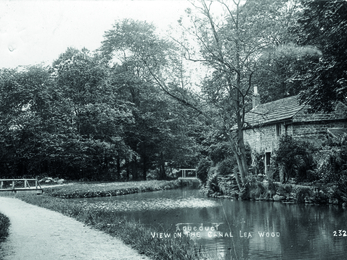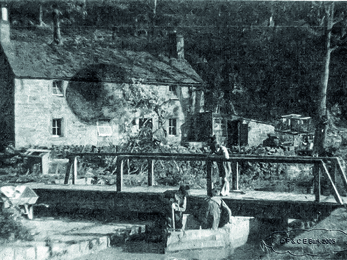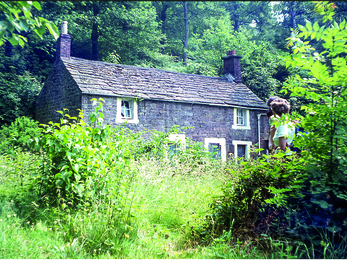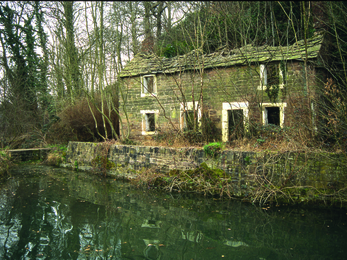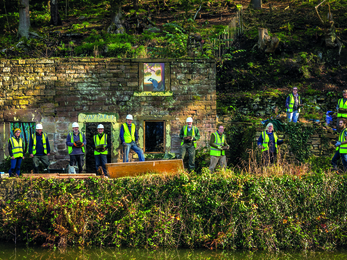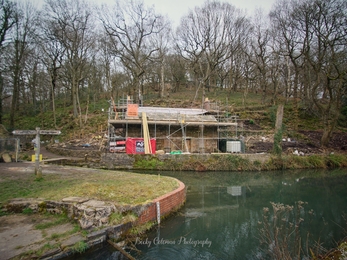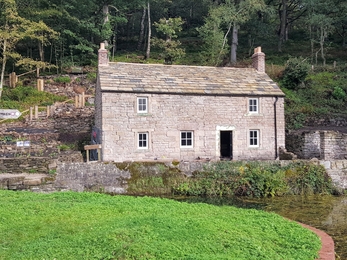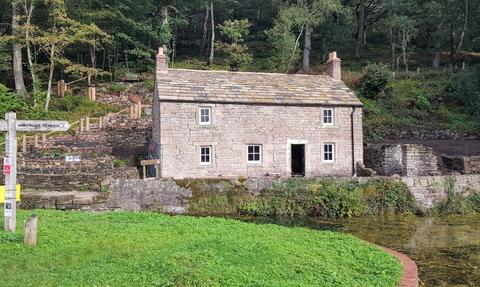
(C) Ron Common / Aqueduct Cottage 2023
Aqueduct Cottage
Aqueduct Cottage is a Grade II listed building situated on the beautiful Cromford Canal at its junction with the Lea Wood Arm. It is a significant asset of the Derwent Valley Mills World Heritage Site.
Situated between our Lea Wood & Derwentside Nature Reserves along the Cromford Canal, a rejuvenated Aqueduct Cottage affords us a unique opportunity to share the importance of Lea Wood and our vision of a more biodiverse Derwent Valley as part of the Trust’s vision of a 30% re-wilded Derbyshire.
The Cottage’s location, in the beautiful setting of the Derwent valley, is an ideal site for a visitors centre to tell the rich history of the Cottage and the surrounding area.
As part of this project, we set up a Crowd Funder campaign in 2019 to help support our work and we would like to say a huge thank you to everybody who donated!
Opening Hours
The cottage is open on Tuesdays, Saturdays and Sundays from 10.00am until 1pm , subject to the weather and volunteer availability.
These dates and times may change when artists and exhibitions are in residency. Please check the events listings on our events page here.
Restoration of the cottage
Volunteers and Derbyshire Wildlife staff came together to take part in this fantastic restoration project. What was once a crumbled ruin, entwined in tree branches and vines, now stands as a beautiful cottage full of charm and character
1996
A team of developers planned to purchase and develop Lea Wood and the remains of
Aqueduct Cottage. A group of villagers from Dethick Lea and Holloway joined forces to create
The Lea Wood Trust in order to protect and preserve the natural beauty and wildlife in the
area. The Lea Wood Trust outbid the developers, by raising over £115,000 through donations.
2012
The Lea Wood Trust gifted Lea Wood and Aqueduct Cottage to Derbyshire Wildlife Trust.
2013
Mansel Architects produced a report for the cottage, funded by the DerwentWISE project,
a 5-year Heritage Lottery-funded programme of natural & cultural conservation projects.
2016
A restoration plan was put into place, and what followed was an inspiring 3-year mission to
gain support for the cottage to be saved, with support and interest from across the globe.
Over £30,000 was raised via a “Buy a Brick” campaign, private donations and free materials
and services provided by businesses.
2018
The Derbyshire Historic Buildings Trust agreed to join forces with Derbyshire Wildlife Trust
in the restoration of the cottage.
2019
Planning consent was agreed and a £35,000 grant
was received from The Pilgrim Trust. A volunteer team
was recruited to help with the restoration. The first
task involved clearing 30 tons of debris from inside
the roofless cottage. With no road access, all materials
were carried 250 yards along the canal towpath.
2020
Once lockdown restrictions eased, a small number of volunteers and builders soldiered on,
replacing the windows and reconstructing the walls. As soon as the remaining volunteers
could join, floor joists were installed, a new floor was laid and the cottage interior started to
take shape.
2021
The chimneys were rebuilt using lime mortar and reclaimed bricks, and the heritage Velux
windows were installed. In keeping with the original cottage, the rear section of the roof
had slate tiles installed, and the front was adorned with stone tiles. Throughout spring, the
volunteers carried out major landscaping work to the cottage grounds and garden. Fifty
steps were dug in by hand behind the cottage to provide safe and easy access up the hill
into Lea Wood.
2022
With the exterior of the cottage close to finish, the hard work to transform the interior began.
The volunteers lime mortared and repaired the walls, ready for the final plastering and
painting and a purpose-built staircase was installed into the
cottage, allowing easier and safer access to the first floor.
2023
The completed cottage opens to the public. The cottage has truly been transformed. Thank you to the staff and
volunteers who have dedicated over 7000 hours to the project
Cottage History
Aqueduct Cottage was built in 1802 as a lengthman and lock-keepers cottage by local industrialist, Peter Nightingale. He wished to build a canal to serve his mills at Lea Bridge and Lea Wood as well as the lead smelting works up in the valley.
Peter Nightingale was given permission for his canal to join the Cromford Canal. He had to maintain the water level in his canal at least one foot above that of the Cromford Canal. This meant that no water would be lost from the Cromford Canal to supply the Lea Wood Arm. The cottage was originally a detached one-up one-down building. At a later date a second cottage was added to the south-east to form a pair of semi-detached cottages. The two were then combined to create a two bedroom cottage with a parlour and kitchen, off which there was also a small scullery.
Life in the cottage
The cottage has had many inhabitants over the years. The first residents were lock-keepers managing the lock gate outside the cottage. The longest residing tenants were members of the Eaton family who occupied the cottage from 1883 to 1946. Ann Eaton was the first of this family to live in the cottage with her husband, Josiah Eaton. They married in February 1869 at Trinity Church, Derby. Together they brought up eight children in the two bedroom cottage. Life in the cottage was a challenge: there were no mains services; drinking water would be acquired from the natural springs in the canal bank, not from the canal itself. The water was then purified by
using a pot with sand in for the water to drain through to clean it for drinking.
Ivy Turberville, granddaughter to Ann Eaton, records how her grandmother managed with limited facilities which were not uncommon in her day. “At the time the house belonged to the Nightingales. Florence Nightingale’s family. Grandma and Florence Nightingale were quite friendly. There was a saying that Grandma used to quote to us when we were children and didn’t want a bath, she said Florence Nightingale advised that with a pint of boiling water, a walnut of soap and a square of flannel anyone can have a bath.” The last tenant in the cottage was a Mr Bowler who left around 1970. It was the council who declared the premises unfit for human habitation and insisted on rehousing Mr Bowler. After a spell of being a shelter for walkers, the cottage was abandoned in 1974, sealing its fate as a ruin
The cottage in the landscape
When the cottage was occupied, the residents lived in a way that was reliant on and deeply connected to the landscape surrounding them, including Lea Wood, located just behind the cottage. The families who lived at the cottage would have kept chickens and grown fruit and vegetables in the walled enclosure in the woods, and with over 90 species of fungi in Lea Wood, the edible varieties would have been harvested for food.
The Nightingale family made their fortune from lead mining and smelting, branching out into cotton spinning due to the success of the Arkwright enterprise nearby at Cromford. The Derwent Valley became home to the world’s oldest factories, the cotton mills of the Industrial Revolution, which are now the Derwent Valley Mills World Heritage Site.
The positioning of the footbridge would have impacted the operation of the Lea Wood Arm lock gates, so it’s unlikely that it was present at that time. The lock keeper and his family probably crossed on the lock gates themselves. When the lock gates ceased to be used, around 1820, it seems that a swing bridge was provided to cross the canal. When the Lea Wood Arm closed to all traffic around 1936, the bridge was replaced by the stone dam that forms the current access to the cottage. The pivot point of the swing bridge and the landing stone opposite can still be seen near the dam.
Lea Wood
Aqueduct Cottage is situated next to Lea Wood Nature Reserve which is a semi-natural ancient woodland, nestled away in the Derwent Valley, with its southern edge meeting the tranquil Cromford Canal.
History of Lea Wood
The woodland is rich with history and home to varieties of flora and fauna. Historical records tell us that during the
medieval and post-medieval periods, Lea Wood was home to local small-scale industry.
Lea Wood was known for its production of white coal and charcoal. Remains of white coal kilns (also known as
Q-pits) have been found in the woodland. They produced a fuel that was used in early forms of lead smelting giving us an interesting window into the past. Quern stones are disc-shaped rounded stones that were used for hand milling of corn and grain, and the style of these quern stones found in Lea Wood suggests that they may date to between c.700 BC and AD400.
Wildlife at Lea Wood
At the end of June 2012 Derbyshire Wildlife Trust was gifted this spectacular woodland by the local community,
represented by The Lea Wood Trust. The reserve offers a variety of habitats, from oak woodland to open grassland and traces of heathland. In fact, the name “Lea” is derived from the Old English word leah meaning “open field, meadow, piece of untilled grassy ground”. During spring and summer, the meadow is alive with an abundance of red campion and greater stitchwort, irresistible to nectar-loving insects and an ideal hunting ground for dragonflies. Not to mention slow worms and grass snakes, which have been spotted around the meadow, hiding amongst the vegetation.
Wilder connecting landscape
The Derwent Valley derives its name from the Brittonic “Deruentiu” meaning “forest of oak trees”. Dominated by the River Derwent, the area also covers surrounding moorland fringes and cloughs, stream and river tributaries, wooded valley sides, marshlands and many flower-rich grasslands, as well as other smaller and more scattered habitats.
Unfortunately, due to woodland clearing and fragmentation associated with increased agriculture and urbanisation, this “forest of oak trees” no longer covers the vast area it used to. Not only have we lost significant areas of woodland, but with them also a large number of species. Despite this, the Derwent Valley is still a very important area for ancient semi-natural woodland, and restoring thisabitat is an important step in ensuring Nature’s Recovery across Derbyshire.
Lea Wood Sculpture Trail
Why not take a stroll around the Derwent Valley and download our sculpture trail leaflet and guide to the area.

